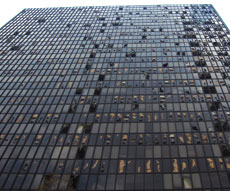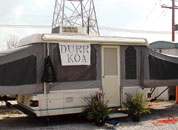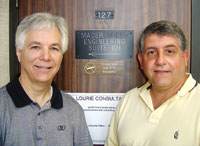 |
For most firms, the first mission was to locate employees and assess their situation. San Francisco-based URS Corp., which says it is the largest engineer in the Gulf region with more than 700 employees, including 500 in New Orleans and suburb Metairie alone. It spent 10 days "trying to find everyone," says Senior Vice President Vincent Provenza, a city native whose own elderly relatives waited five days for rescue. With phones and e-mail down, URS resorted to placing ads in local newspapers.
URS has crammed many displaced employees into its Baton Rouge office, which grew 50% overnight, Provenza says. He believes the Metairie office will be operational by early October. "Out of 500 employees, only one asked to be transferred out of state," he says.
 |
| SWATEK |
MWH, Broomfield, Colo., with about 60 employees in four Louisiana locations, suffered wind damage to one 14th floor high-rise office near the Superdome and had another "underwater," says Mark Swatek, president of its municipal division. The firm is program manager for New Orleans $650-million sewer rehabilitation program.
 |
| Blown out. MWH suffered office damage in building near Superdome. (Photo courtesy of MWH) |
MWH provided temporary housing for displaced employees, donated vacation time from peers and promised jobs through January, but many "realized the complete disruption in the business and became very insecure," says MWH CEO Robert Uhler.
With a disaster preparedness program enacted two years ago, MWH was able to restart computer servers and save most files, says Swatek. "But I dont know the condition of the hard files," he adds. Uhler estimates that damage to the firm could run as high as $2.5 million.
Most area contractors seemed to escape heavy damage to offices and yards but now face a bigger challenge in housing and even feeding displaced employees and many potential new ones lining up for work. "Were adding new people every day," says Fred Yoder, president of Durr Heavy Construction, Harahan, La., a suburb of New Orleans.
 |  |
| Regrouped. Durr Heavy Construction houses some displaced workers in trailer, says President Fred Yoder (left). (Photos by Angelle Bergeron for ENR). | |
With his home submerged in the citys Lakeview district, Yoder now resides in a converted trailer on office property, along with other needed employees. His wife and daughters prepare up to 200 sandwiches a day to feed the crew. Durr specializes in demolition, site preparation and utility work.
Firms gripe about the inability to obtain portable showers for employees, which they say have been earmarked for the Federal Emergency Management Agency, and about having equipment "appropriated" by military, state and local authorities. "We were lucky," says Blake Andrews, president of B&K Construction Co., Mandeville. "We had one piece that the Army confiscated, but it was returned."
 |
|
Shambles. Gulfport-based Roy Anderson Corp. suffered light damage to its facilities, but many casinos and hotels it built in the area, such as the Hard Rock above, were damaged or destroyed. (Photo by Michael Goodman for ENR) |
Other firms endured sad ends to hard work. The new Hard Rock Café casino-hotel in Gulfport, Miss., built by Roy Anderson Corp., also based there, received its certificate of occupancy the Friday before Katrina slammed into the Gulf Coast on Aug. 29, seriously damaging the structure, says Gina DAmbrino, director of marketing. But the firm will gain new work in repairing the structure as well as a number of others it built that also were damaged. With casinos a key economic driver in the region, owners expect to open them quickly.
Anderson escaped serious damage by moving employees and key functions to inland offices in advance, but "we had several jobsites on Beach Blvd. blown to oblivion," Dambrino says.
 |
| Taken In. Displaced Lourie (right) houses firm with Mader. (Photo courtesy of Lourie Consultants) |
Smaller industry firms depended on colleagues for support. David Lourie, partner in Lourie Consultants, a two-person geotechnical firm that was displaced from its Metairie office, evacuated Saturday to Lafayette, a 150-mile trip that took eight hours, he says. "The outpouring of help has been absolutely amazing," he says. Lourie now is sharing office space there with Mader Engineering, a client. President Tim Mader says he "waited days" to decide how to help displaced individuals until "he woke up in the middle of the night" and wondered where Lourie was. Lourie intends to stay in Lafayette for time being.
Lourie worries about the future of his firm, with key projects interrupted or likely halted by Katrina. "There are sites we cant even get to," he says. Lourie points to a contract for property environmental assessments the firm was set to do for a client in Port Fouchon, the heavily damaged oil services support area south of New Orleans. "Work has come to a grinding halt," he says. "That project was worth in excess of $25,000 to us."
The collapse of New Orleans water and wastewater systems will indefinitely halt MWHs project. "We were halfway through the project, but it now could be three years off," says Uhler. "Its no longer the priority."
|
New Opportunities
Needed emergency services have helped contractors and engineers gain new work, some winning multimillion-dollar contracts or smaller subcontracts from FEMA, the Corps of Engineers and municipalities. MWH now is doing water and wastewater assessments for Baton Rouge and Jefferson Parish, near New Orleans. It won a $1-million contract from New Orleans to certify debris haulers outside the flood zone.
URS, which does a lot of work for regional petrochemical firms, says it is taking advantage of clients shutting down operations, to help with plant turnarounds. "Were actually busier now than we were before," he says.
Engineer Camp Dresser & McKee Inc., Cambridge, Mass., which has 60 people in the region, is a FEMA subconsultant, evaluating medical facilities for structural and environmental damage, on one contract. Firms say that confusion among local and federal officials has created lots of "chaos," but Provenza says that local employees are motivated to rebuild quickly.
Some firms worry about the future. Roy Glapion, president of Citywide Testing & Inspection, New Orleans, a black-owned business that was a sub on the citys sewer program, says that many of his 52 severely impacted employees have scattered across the U.S. and may not return, "although they have jobs."
Glapion, with city roots that go back 200 years, says that with some projects now on hold, he worries about how to find new ones. Citywide had a contract to do construction material testing related to the $325-million expansion of the Ernest Morial Convention Center in New Orleans. "We were embarking on one of our best years yet before all hell broke loose," he says.
Glapion hopes local firms will be included in FEMAs ambitious rebuilding plans, but sees little evidence of that so far. "Now work is just based on friendships and relationships," he says.
long with thousands of other businesses in Gulf Coast areas damaged by Katrina, engineering firms and contractors are weathering their own losses, even as many rush to help local clients and hard-hit cities, and gain a foothold in the growing recovery effort. Some say that it will take a while to get their businesses back on track.

Post a comment to this article
Report Abusive Comment